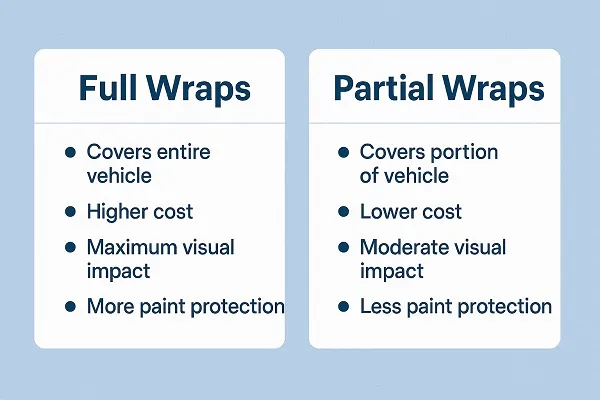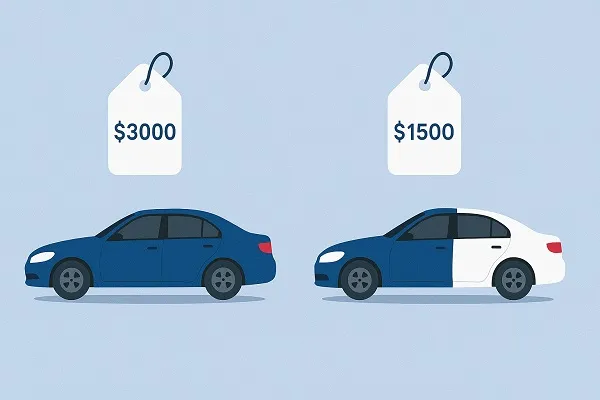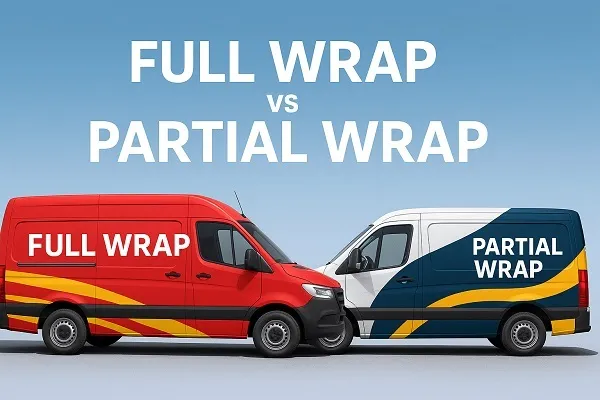When deciding how to advertise your business or refresh the look of your vehicle, understanding the difference between a full wrap and a partial wrap is key. Both options offer unique benefits, and the choice can significantly impact cost, visibility, and branding potential.
This article breaks down the key differences between full wraps and partial wraps, helping you make an informed decision that suits your needs and budget.
What Is a Full Vehicle Wrap?
A full vehicle wrap covers every visible painted surface of a car, truck, van, or trailer with vinyl graphics or solid color wrap. This includes:
- Hood
- Roof
- Trunk
- Doors
- Side panels
- Bumpers
- Mirrors
Benefits of Full Wraps
A full wrap offers complete design freedom and maximum exposure for your message or brand. Some of the top benefits include:
- Maximum Brand Visibility: With the entire vehicle wrapped, your logo, colors, and message are highly visible from all angles.
- Uniform Design: Allows for consistent and uninterrupted graphic design across the whole vehicle.
- Paint Protection: Shields the original paint job from UV rays, scratches, and weather damage.
- Color Change: A full wrap can completely change the look of your vehicle without the permanence of paint.
Ideal Use Cases for Full Wraps
- Fleet branding for delivery trucks or service vehicles
- Event or promotional vehicles
- Businesses looking for high-impact mobile advertising
- Luxury or exotic car owners wanting a temporary color change
What Is a Partial Vehicle Wrap?
A partial vehicle wrap covers only specific sections of the vehicle, usually between 25% to 75% of its surface. It strategically integrates vinyl graphics with the vehicle’s existing paint color to create a dynamic visual effect.
Common Areas for Partial Wraps
- Side panels
- Rear doors or windows
- Hood or trunk
- Tailgate (for trucks or SUVs)
Benefits of Partial Wraps
Partial wraps can be just as impactful when designed properly. Here’s why many businesses choose them:
- Cost-Effective: Requires less material and labor, making it more budget-friendly.
- Faster Installation: Typically quicker to install and easier to remove or update.
- Strategic Branding: Still allows for strong brand visibility without covering the entire vehicle.
- Custom Integration: Blends vinyl with existing paint for a sleek, professional look.
Key Differences Between Full Wraps and Partial Wraps

Understanding the core distinctions between a full wrap vs a partial wrap helps you align your goals with the best option. Here’s a direct comparison:
| Feature | Full Wrap | Partial Wrap |
|---|---|---|
| Coverage | 100% of the vehicle | 25–75% of the vehicle |
| Cost | Higher | Lower |
| Installation Time | Longer (1–3 days) | Shorter (hours to 1 day) |
| Design Flexibility | Maximum | Limited by coverage area |
| Paint Protection | Full protection | Partial protection |
| Visibility | Highest | Moderate, depending on placement |
Which One Is Right for Your Business?
Choose a Full Wrap If:
- You want your vehicle to act as a billboard-on-wheels.
- Consistency across a fleet is important.
- Your business needs high-impact marketing.
- You want to protect the entire paint job underneath.
Choose a Partial Wrap If:
- You’re working with a limited budget.
- Your branding works well with the vehicle’s base color.
- You want a quicker installation or plan to update the design often.
- You’re testing mobile advertising for the first time.
Design Considerations for Vehicle Wraps
Whether you choose a full or partial wrap, the design is crucial to its effectiveness. Some tips for impactful wrap design include:
- Keep messaging clear and concise.
- Use high-contrast colors for readability.
- Prioritize contact info (website, phone number, social media).
- Make use of bold graphics and brand colors.
If going for a partial wrap, ensure that the design blends naturally with the vehicle’s paint color. A mismatched design can look unprofessional and reduce the visual appeal.
Durability and Maintenance
Full Wrap Maintenance
- Wash regularly with mild soap and water.
- Avoid pressure washing edges.
- Use wrap-safe polish for extra shine.
Partial Wrap Maintenance
- Pay attention to the transition areas between vinyl and paint.
- Use the same care techniques as a full wrap.
- Inspect vinyl edges for lifting or peeling.
Both types of wraps can last 5–7 years if properly maintained, although environmental factors like sun exposure and road salt can affect lifespan.
Cost Comparison: Full Wrap vs Partial Wrap

Cost is often the deciding factor between full and partial wraps. Here’s a general breakdown:
- Full Vehicle Wrap: $2,500 – $6,000+
(Depends on vehicle size, material type, and design complexity) - Partial Vehicle Wrap: $800 – $2,500
(Depends on surface area and placement)
If you’re branding multiple vehicles or changing wraps frequently, a partial wrap may make more sense financially. However, if you want maximum ROI from mobile advertising, a full wrap pays off with increased impressions and brand awareness.
Common Myths About Vehicle Wraps
“Partial wraps don’t look professional.”
False. With smart design and strategic placement, a partial wrap can look sleek and polished—especially when it complements the vehicle’s existing paint.
“You need to repaint before wrapping.”
Nope. Wraps adhere best to clean, smooth, original paint. Repainting may actually hurt adhesion if not done correctly.
“Full wraps damage the paint.”
Incorrect. In fact, vinyl wraps protect the original paint from UV rays, light scratches, and minor abrasions. When installed and removed properly, they leave the paint untouched.
Final Word: Which Wrap Is Best?
Choosing between a full wrap and a partial wrap depends on your goals, budget, and how much impact you want to make. If you’re looking for full-body branding, a professional appearance, and maximum exposure, a full wrap is worth the investment. If you’re prioritizing budget and targeting a more subtle approach while still getting visibility, a partial wrap can be just as effective—especially when paired with a strong design.
Either way, vehicle wraps are a high-ROI marketing tool and a great way to give your vehicle a fresh, eye-catching look. Whether full or partial, the right wrap turns your car, truck, or van into a mobile advertisement that works 24/7.

